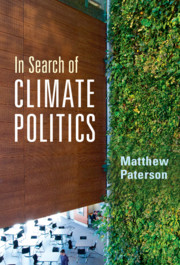Book contents
- In Search of Climate Politics
- In Search of Climate Politics
- Copyright page
- Contents
- Figures and Tables
- Contributors
- Preface
- Acknowledgements
- Acronyms
- 1 Introduction
- 2 In Search of Climate Politics
- 3 Making Climate Policy in the City of Ottawa
- 4 Networked Governance and Carbon Accounting in Ottawa
- 5 Complete Streets and Its Discontents
- 6 Intensifying Conflicts
- 7 Mapping Climate Experimentation in Ottawa
- 8 The University of Ottawa
- 9 Renewing Democratic Politics
- 10 Conclusions
- References
- Index
3 - Making Climate Policy in the City of Ottawa
Published online by Cambridge University Press: 02 November 2021
- In Search of Climate Politics
- In Search of Climate Politics
- Copyright page
- Contents
- Figures and Tables
- Contributors
- Preface
- Acknowledgements
- Acronyms
- 1 Introduction
- 2 In Search of Climate Politics
- 3 Making Climate Policy in the City of Ottawa
- 4 Networked Governance and Carbon Accounting in Ottawa
- 5 Complete Streets and Its Discontents
- 6 Intensifying Conflicts
- 7 Mapping Climate Experimentation in Ottawa
- 8 The University of Ottawa
- 9 Renewing Democratic Politics
- 10 Conclusions
- References
- Index
Summary
Like many cities, the City of Ottawa got interested in climate change early on. It set ambitious targets, only to realize they were extremely demanding if not impossible to meet. It thus scaled back its ambition, and the history of its response at the overall level of the City Council can be characterized in two ways. On the one hand, it responded to the emergence of city networks on climate change to do enough to report to the network of Canadian cities – the Partnership for Climate Protection – and meet its expectations. But these expectations have throughout been minimal – to create inventories of emissions, develop plans for them, and monitor progress. On the other hand, the City has, episodically, generated moments of enthusiasm for action on climate change, developing more overarching plans and a variety of specific initiatives. These bursts of energy occurred around 1991, 2004, and 2012–13. But in none of them did the burst of energy turn into sustained attention. We focus our analysis on the period through to 2014 when the Air Quality and Climate Change Management Plan (AQCCMP) was adopted.1 In part this is because the main patterns are easily identified up to this date, and in part because Chapters 5 and 6 discuss two particular aspects of the more recent politics (Complete Streets, and intensification) in more detail.
- Type
- Chapter
- Information
- In Search of Climate Politics , pp. 30 - 45Publisher: Cambridge University PressPrint publication year: 2021



